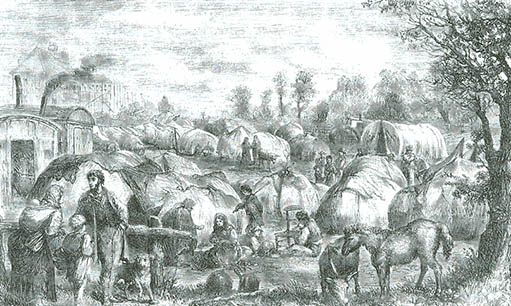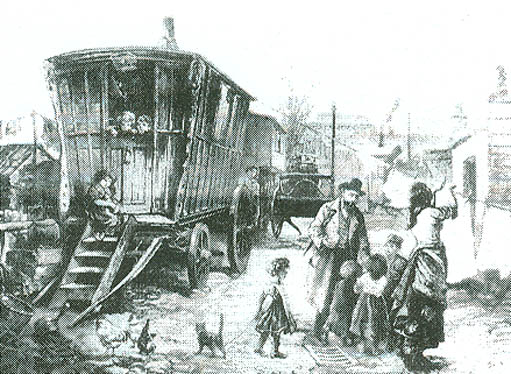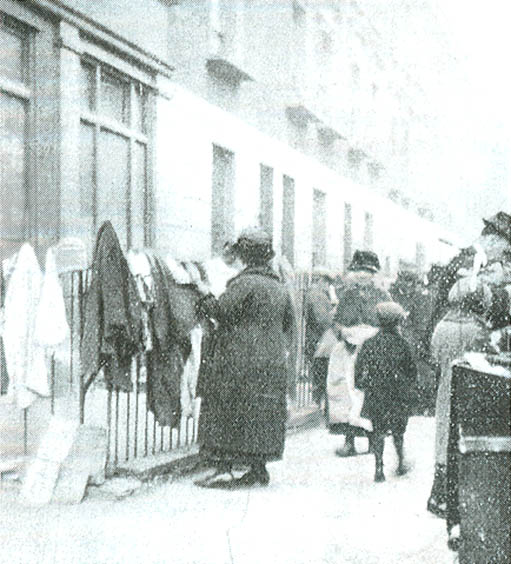PORTOBELLO
CARNIVAL FILM FESTIVAL 2008
1
Portobello Carnival Film Festival 2008
2 Lord
Holland’s Slavery to Work Scheme
3 The
Notting Dale Gypsies
4 Portobello
Busker Parades
5 1966
London Free School Michaelmas Fayre
6 1968
Interzone International Times Fair
7 1977
Two Sevens Clash Punky Reggae Party
8 1983/4
Aswad Live And Direct Carnival
9 1995
Hugh Grant Mas and Mayhem
PART 3
The Notting Dale Gypsies

In the final stages of urbanisation, the Notting Dale
gypsies were integrated into the community by a combination
of do-gooding and health restrictions. The 1870s gypsy
street in Mary Place was described by George Barrow
as ‘chock full of crazy, battered caravans of
all colours… dark men, wild looking women and
yellow faced children.’ The local king of the
gypsies, Mesach, Thomas or Old Hearn, was a 90 year
old veteran of the Napoleonic wars who had travelled
the country chair-bottoming before settling in a comfortably
converted advertising van between two trees.

1870s Portobello Market Carnival
By the early 1870s, Portobello had succeeded
the original local market on Norland Road, and its ‘general
London notoriety’ was assured for ‘cheery
cries, surging crowds and heavily laden stalls.’
Sir William Bull MP wrote of the early market in ‘Some
Recollections of Bayswater 50 Years Ago’, for
the Bayswater Chronicle in 1923: ‘Columbus discovered
Porto Bello in 1502. We discovered Portobello Road about
370 years later. Carnival time was on Saturday nights
in the winter, when it was thronged like a fair…
in the side-streets were side-shows’ including
vendors of patent medicine, conjurors and itinerant
musicians.
Wormwood Scrubs Fair
In the late 19th century Little Wormwood Scrubs
hosted fairs with roundabouts and drinking booths, and
Sunday morning bare-knuckle bouts; one of which resulted
in a local gypsy being tried for murder but found innocent.
According to Florence Gladstone in Notting Hill in Bygone
Days, ‘in the summertime the proceedings every
Sunday evening were so disorderly that respectable people
could not walk in that direction. It was only after
the Wormwood Scrubbs regulation bill was passed in 1879
that this corner settled down to an orderly existence.’
This could be the fair referred to by the 1966 Carnival
founder Rhaune Laslett. In the opening chapter of Abner
Cohen’s Masquerade Politics, ‘A Resurrected
London Fair’, she’s quoted as saying it
was ‘a revival of the Notting Hill annual fair
that had been traditionally held in the area until it
was stopped at the turn of the century.’
1880s Canboulay Riots
In Trinidad in the 1880s there were major clashes
between the colonial police and carnival revellers in
the Canboulay riots. Canboulay fights between rival
bands, where sticksmen traditionally resolved personal
differences, began to take on revolutionary significance.
After a Carnival riot in San Fernando in 1882, when
police tried to stop playing early, drums were banned
from the Trinidad Carnival for being barbaric, and to
prevent them becoming a focal point of mounting racial
tension.
The Rio Carnival and New Orleans Mardi Gras
The Rio Carnival started up in 1888 after the
abolition of slavery in Brazil and a severe drought
which resulted in a former slave community in the city.
In New Orleans in the early 20th century the first black
krewe paraded with a King Zulu character mocking the
white Carnival royalty with a banana stalk sceptre and
lard-can crown. Back in Brazil the Rio samba schools
formed in the 1920s and 30s.
1904 Battle of Portobello Road
GK Chesterton’s local literary classic
The Napoleon of Notting Hill (written at the turn of
the 20th century) features a fairytale battle, more
of a riot really, at the beginning of Portobello Road.
Prophetically, Notting Hill wins the war but is changed
for the worse and loses the final battle to the rest
of London:
“As we walked wearily round the corner, something
happened. When something happens, it happens first,
and you see it afterwards. It happens itself, and you
have nothing to do with it. It proves a dreadful thing
– that there are other things besides one’s
self. I can only put it this way. We went round one
turning, two turnings, three turnings, four turnings,
five. Then I lifted myself slowly up from the gutter
where I had been shot half senseless, and was beaten
down again by living men crashing on top of me, and
the world was full of roaring, and big men rolling about
like ninepins.” Buck looked at his map with knitted
brows. “Was that Portobello Road?” he asked.
“Yes”, said Barker, “Yes, Portobello
Road – I saw it afterwards: but, my God –
what a place it was!”…
“Notting Hill has fallen; Notting Hill has died.
But that is not the tremendous issue. Notting Hill has
lived.” “But if”, answered the other
voice, “if what is achieved by all these efforts
be only the common contentment of humanity, why do men
so extravagantly toil and die in them? Has nothing been
done by Notting Hill that any chance clump of farmers
or clan of savages would not have done without it? What
might have been done to Notting Hill if the world had
been different may be a deep question; but there is
a deeper. What could have happened to the world if Notting
Hill had never been?” The other voice replied;
“The same thing that would have happened to the
world and all the starry systems if an apple-tree grew
6 apples instead of 7; something would have been eternally
lost. There has never been anything in the world absolutely
like Notting Hill. There will never be anything like
it to the crack of doom. I cannot believe anything but
that God loved it as he must surely love anything that
is itself and unreplaceable. But even for that I do
not care. If God, with all his blunders, hated it, I
loved it.”
1914 Anti-German Electric Cinema Riot
In the 1909 Interesting History of Portobello
Road, Edward Woolf chanced fate stating that ‘orderliness
exists in the extreme, and a police charge in Portobello
Road on a Saturday night is the rarest occurrence.’
At the outbreak of World War 1, in the next Notting
Hill race riot the Electric Cinema was attacked by a
mob who accused the German manager of signalling to
Zeppelins from the roof.
Bangor Street Rag Fair

Bangor Street, the most notorious road of the Notting
Dale ‘Special Area’ slum (on the site of
Henry Dickens Court), was known as ‘Do as you
like Street’, a place where ‘no one left
their door closed’, and the venue of the Rag Fair.
At the turn of the 20th century, the local district
nurses were reported ‘valiantly holding their
own in spite of the disturbance caused by nightly brawls
and the noisy and unsavoury Sunday markets.’
Valerie Wilson recalled in an interview by the Notting
Dale Urban Studies group: “They used to threaten
us – don’t go up rag fair and the first
thing we did when we got outside, we forgot all about
it and went straight through rag fair… that was
really like a film show, they used to hang old bits
of clothing on the railings… the street would
throng with people… there was a group of men who
came out the war and they were all ex-servicemen, big
tall strong men, and they couldn’t get work, so
they formed this group and they dressed up in tulle
like a fairy in a pantomime and they made their faces
up, hideous like white faces and red rouged cheeks and
red false curls and they used to dance and people, children
and grown-ups, they formed a circle or square and people
would throw a penny in.”
As an example of local characters ‘who make the
most of the notoriety of their surroundings’,
and the slumming tradition, a Bangor Street urchin recounted
some “hunderworld business”, in which “the
char-a-banc blokes bring the toffs to the end of the
street, they pay 6 shillings and 6 pence a time, could
you believe it? When the tic-tac man gives the word
then father sloshes mother, she screams “Murder!”
and I slosh father, then Ennis over the way sloshes
his old girl and a free fight starts all around…
Dad gives me a sprasy (6 pence).” Bangor and Wilsham
Street also hosted more respectable Coronation street
parties.
1930s Notting Hill Carnival
The 1930s Notting Hill Carnival, or the Princess
Louise Hospital Carnival, consisted of a procession
from the hospital along Pangbourne Avenue, Latimer Road,
Silchester Road and Clarendon Road to Kensington Gardens.
The 1934 Carnival line-up featured a girl with traffic
lights on her head, Britannia, a Scotsman, a milkmaid,
bellboy, clown and a blacked up youth. This could be
the fair before the last war referred to by Michael
Horovitz as being revived in the 1966 London Free School
Fair.
4 Portobello
Busker Parades
|





